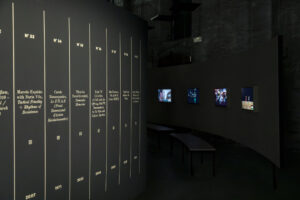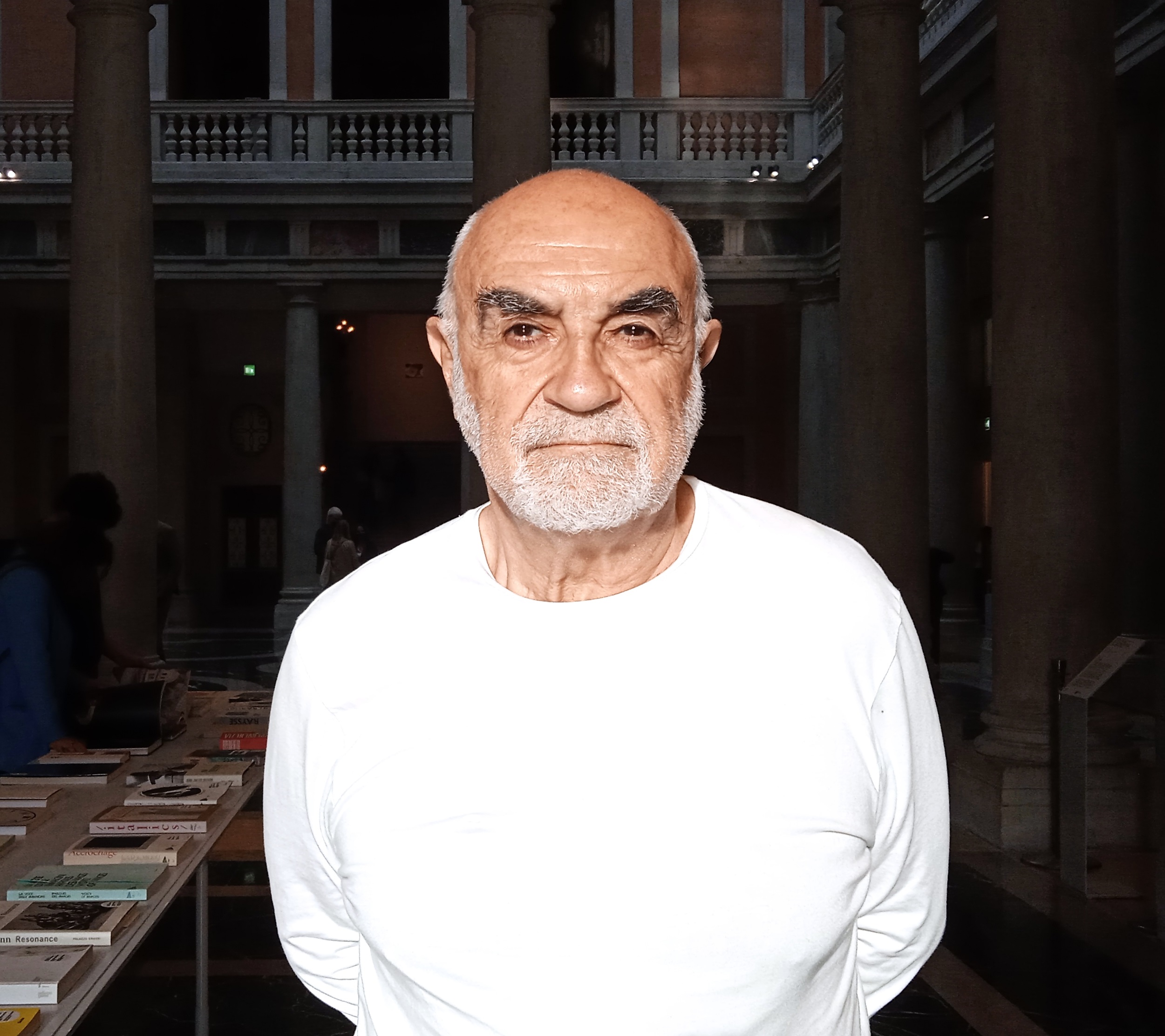«Disobedience Archive is a multi-phase, mobile and evolving video image archive that focuses on the relationship between artistic practices and political action. The project aims to be an atlas of contemporary resistance tactics, from direct action to counter-information, from constituent practices to forms of bioresistance. It functions as a “user manual” for social disobedience by including hundreds of documentary elements spanning several decades. Presented fifteen times in different countries since 2005, Disobedience Archive transforms each time without ever taking on a definitive configuration. Whether it takes the form of a parliament, a school or a community garden, the project transforms the archive – typically static and taxonomic – into a dynamic and generative device».

“Disobedience Archive” – Marco Scotini, 60th International Art Exhibition – La Biennale di Venezia, “Stranieri Ovunque – Foreigners Everywhere”, photo by Marco Zorzanello, Courtesy: La Biennale di Venezia
This is a passage from the text that welcomes the visitor to the Biennale pavilion dedicated to the Disobedience Archive. It is difficult to find other words to introduce this project by Marco Scotini created together with Arnold Braho, with the coordination of Arndris Brinkmanis and the visual concept of Lilia Di Bella and Chiara Figone, as well as the contributions of students from the Nuova Accademia di Belle Arti in Milan and Rome. The ostentatiously militant language cannot help but put a visitor to social centers in the “antagonist area” or a reader of workerist and neo-worker bibliography at ease, but it certainly does not clash with the spirit and style of this entire Biennale, where the condemnation of capitalism, imperialism and colonialism seem almost obligatory, as if it were a canon which it was advisable to… obey. Which – as will be said – offers the right to some sharp considerations.

“Disobedience Archive” – Marco Scotini, 60th International Art Exhibition – La Biennale di Venezia, “Stranieri Ovunque – Foreigners Everywhere”, photo by Marco Zorzanello, Courtesy: La Biennale di Venezia
In the large entrance hall of the Arsenale dedicated to this archive (or rather to this “dynamic and generative device”) there are around forty dimly lit screens arranged in concentric circles, where videos and documentary films are broadcast without interruption the most disparate situations, in terms of time (from ’68 to the present day), space (about no continent excluded), as well as social and existential dimensions. The struggles for survival of farmers in sub-Saharan Africa are thus combined with American LGBT+ demonstrations. The vicissitudes of a population in Bombay faced with the dismantling of a slum precede or follow the images of persecution of migrants in Belgium, while the mobilization of French filmmakers in favor of sans papiers appear next to a portrait of the activist, politician and actress Marcella Di Folco. And so on.

“Disobedience Archive” – Marco Scotini, 60th International Art Exhibition – La Biennale di Venezia, “Stranieri Ovunque – Foreigners Everywhere”, photo by Marco Zorzanello, Courtesy: La Biennale di Venezia
Now it is clear that the intent and purpose of each of the works presented were mostly to document in detail, specifically, a singular social, anthropological or biographical reality, for which the properly artistic quality is supposed to be conferred on them precisely by being presented all together, without distinction. At the same time it is clear that in this way the common trait is supposed to emerge, that sort of spirit of disobedience which is both an aesthetic and a political theme at the center of the archive. However, more than one doubt remains. First of all, such artistic promotion ultimately only penalizes the documentary specificity of these videos and films, inducing the visitor to pay attention not to what each has to offer on its own but to what is presumed to exist between one and the other. of them.

“Disobedience Archive” – Marco Scotini, 60th International Art Exhibition – La Biennale di Venezia, “Stranieri Ovunque – Foreigners Everywhere”, photo by Marco Zorzanello, Courtesy: La Biennale di Venezia
In favor of the Disobedience Archive approach it will be said that this is how the world works, in art as in politics and elsewhere and that everywhere what counts is not the real contents, compared to things, but the relationships, the exchange, the communication: relationships, exchanges, communication of which disobedience would be none other than the most authentic expression, in its desire to be in radical contrast to any hierarchy considered in itself authoritarian, top-down, self-referential. It’s a shame that, more recently, the world is taking another direction that is less relational, swinging and communicative, and rather prone to horrors and endless war catastrophes. One then wonders why all the proliferation of disobedient experiences so scrupulously collected and celebrated by Scotini’s project have not at least hindered this now looming dark destiny (the signs of which appear in the Biennale thanks only to meritorious and sporadic exceptions[1], such as those of the Polish pavilion with the participatory video installation Repeat after me II by the Open Group collective and the Egyptian pavilion with the work Drama 1882 by Wael Shawky).

“Disobedience Archive” – Marco Scotini, 60th International Art Exhibition – La Biennale di Venezia, “Stranieri Ovunque – Foreigners Everywhere”, photo by Marco Zorzanello, Courtesy: La Biennale di Venezia
The inevitable reflection then returns on how much the anti-capitalist, anti-colonial, anti-imperialist (and let’s add even disobedient) fashion of quite a bit of contemporary art has found itself, in spite of itself, compensating for the void of ideals and values, even aesthetic ones, that the neoliberal apologia and hyper-capitalist of free trade and the “cult of communication” (as Lucia Tozzi rightly calls it in L’invenzione di Milano, Cronopio edizioni, 2023) has created, before starting its recent reconversion according to the most ancestral and deadly impulses. In short, the fact that the West has had and has its faults seems to have become a theme that no longer causes scandal, so much so that it is now a fashionable, almost predictable theme in contemporary art; the important thing from now on seems to be to obey (!) the military propaganda according to which there is something worse in the rest of the world that requires its annihilation.
[1] https://www.juliet-artmagazine.com/en/biennale-arte-2024-a-journey-among-the-national-pavilions/
Info:
Disobedience Archive – Marco Scotini
Ursula Biemann, Black Audio-Film Collective, Seba Calfuqueo, Simone Cangelosi, Cinéastes pour les sans-papiers, Critical Art Ensemble, Snow Hnin Ei Hlaing, Marcelo Expósito with Nuria Vila, Maria Galindo & Mujeres Creando, Barbara Hammer, mixrice, Khaled Jarrar, Sara Jordenö, Bani Khoshnoudi, Maria Kourkouta & Niki Giannari, Pedro Lemebel, LIMINAL & Border Forensics (Lorenzo Pezzani, Jack Isles, Giovanna Reder, Stanislas Michel, Chiara Denaro, Alagie Jinkang, Charles Heller, Kiri Santer, Svitlana Lavrenchuk, Luca Obertüfer), Angela Melitopoulos, Jota Mombaça, Carlos Motta, Zanele Muholi, Pınar Öğrenci, Daniela Ortiz, Thunska Pansittivorakul, Anand Patwardhan, Pilot TV Collective, Queerocracy, Oliver Ressler and Zanny Begg, Carole Roussopoulos, Güliz Sağlam, Irwan Ahmett & Tita Salina, Tejal Shah, Chi Yin Sim, Hito Steyerl, Sweatmother, Raphaël Grisey and Bouba Touré, Nguyễn Trinh Thi, James Wentzy, Želimir Žilnik
60th International Art Exhibition – La Biennale di Venezia
20/04 – 24/11/2024
Venezia, Arsenale
https://www.labiennale.org/it/arte/2024

Valerio Romitelli (born in Bologna in 1948) taught, researched and lectured in Italy and abroad. His disciplines: History of political doctrines, History of political movements and parties, Methodology of the social sciences. Among his latest publications: L’amore della politica (2014), La felicità dei partigiani e la nostra (2017), L’enigma dell’Ottobre ‘17 (2017), L’emancipazione a venire. Dopo la fine della storia (2022).






NO COMMENT